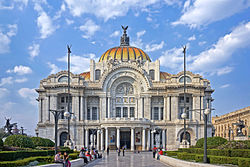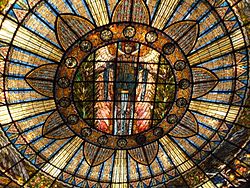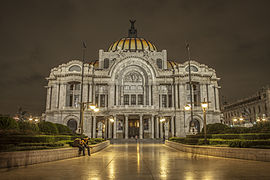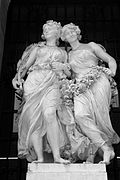
Diego María de la Concepción Juan Nepomuceno Estanislao de la Rivera y Barrientos Acosta y Rodríguez, known as Diego Rivera, was a prominent Mexican painter. His large frescoes helped establish the mural movement in Mexican and international art.

Arturo García Bustos was a Mexican painter and print maker. He is known as one of “Los Fridos” students who studied under Frida Kahlo at her home in Coyoacán.

Arnold Belkin was a Canadian-Mexican painter credited for continuing the Mexican muralism tradition at a time when many Mexican painters were shifting away from it. Born and raised in western Canada, he trained as an artist there but was not drawn to traditional Canadian art. Instead he was inspired by images of Diego Rivera's work in a magazine to move to Mexico when he was only eighteen. He studied further in Mexico, focusing his education and his career mostly on murals, creating a type of work he called a "portable mural" as a way to adapt it to new architectural style. He also had a successful career creating canvas works as well with several notable series of paintings. He spent most of his life and career in Mexico except for a stay in New York City in the late 1960s to mid-1970s. His best known works are the murals he created for the University Autónoma Metropolitana in the Iztapalapa borough of Mexico City.

The Museo de Arte Moderno (MAM) is a museum dedicated to modern Mexican art located in Chapultepec Park in Mexico City.
José Raúl Anguiano Valadez was a notable Mexican painter of the 20th century, part of the “second generation” of Mexican muralists which continued the tradition of Diego Rivera, José Clemente Orozco and David Alfaro Siqueiros but experimented with it as well. Anguiano was born during the height of the Mexican Revolution, which would inspire a majority of his mural painting. He studied painting in his hometown of Guadalajara before moving to Mexico City to begin his career. His first major exhibition was held at the Palacio de Bellas Artes, at age 20. His works include over 100 individual and collective exhibitions with 50 murals, mostly in Mexico and the United States. As he continued his artistry with aspects of the Mexican muralism movement, he also experimented with other styles such as Cubism, Surrealism and Expressionism, with themes such as clowns and prostitutes. However, his most famous painting is “La espina” which depicts a Mayan woman digging a thorn out of her foot with a knife. His later works concentrated on depicting Mexico in vivid colors and traditional imagery.

Leopoldo Flores was a Mexican artist mostly known for his murals and other monumental works which are concentrated in the city of Toluca, State of Mexico. He was born into a poor family in rural State of Mexico, but his artistic ability was evident early and he was able to attend the Escuela Nacional de Pintura, Escultura y Grabado "La Esmeralda" and receive a scholarship to study in Paris. His best known works are the Cosmovitral a large work in stained glass and the Aratmósfera, a “land art” piece both located in Toluca. The first is used as a symbol for the State of Mexico and the latter dominates the main stadium and the hill behind it at the main campus of the Universidad Autónoma del Estado de México (UAEM). He received a number of recognitions of his work from the State of Mexico and an honorary doctorate from the UAEM, which also founded the Museo Universitario Leopoldo Flores to house and promote his work. Despite advanced Parkinson's disease, until his death Flores was still an active artist.

The Palacio de Correos de México, also known as the "Correo Mayor" is located in the historic center of Mexico City, on the Eje Central near the Palacio de Bellas Artes. It was built in 1907, when the Post Office became a separate government entity. Its design and construction was the most modern at the time, including a very eclectic style which mixed several different traditions, mainly Neo-Plateresque, into a very complex design. In the 1950s, the building was modified in a way that caused stress and damage, so when the 1985 earthquake struck Mexico City, it was heavily damaged. In the 1990s, restoration work has brought the building back to original construction and appearance.

José Chávez Morado was a Mexican artist who was associated with the Mexican muralism movement of the 20th century. His generation followed that of Diego Rivera, José Clemente Orozco and David Alfaro Siqueiros. Although Chávez Morado took classes in California and Mexico, he is considered to be mostly self-taught. He experimented with various materials, and was an early user of Italian mosaic in monumental works. His major works include murals at the Ciudad Universitaria, Secretaría de Comunicaciones y Transportes and Museo Nacional de Antropología in Mexico City as well as frescos at the Alhóndiga de Granaditas, which took twelve years to paint. From the 1940s on, he also worked as a cultural promoter, establishing a number of cultural institutions especially in his home state of Guanajuato including the Museo de Arte Olga Costa - José Chávez Morado, named after himself and his wife, artist Olga Costa.
Fanny Rabel, born Fanny Rabinovich, was a Polish-born Mexican artist who is considered to be the first modern female muralist and one of the youngest associated with the Mexican muralism of the early to mid 20th century. She and her family arrived to Mexico in 1938 from Europe and she studied art at the Escuela Nacional de Pintura, Escultura y Grabado "La Esmeralda", where she met and became friends with Frida Kahlo. She became the only female member of “Los Fridos” a group of students under Kahlo’s tutelage. She also worked as an assistant and apprentice to Diego Rivera and David Alfaro Siqueiros, painting a number of murals of her own during her career. The most significant of these is "Ronda en el tiempo" at the Museo Nacional de Antropología in Mexico City. She also created canvases and other works, with children often featured in her work, and was one of the first of her generation to work with ecological themes in a series of works begun in 1979.

Adamo Boari was an Italian Art Nouveau and Art Deco civil engineer and architect, he had a very active career in Mexico and he is known for the construction of notable Historicist architectural works in this country.

María Dolores Velázquez Rivas, better known as "Lola" Cueto was a Mexican painter, printmaker, puppet designer and puppeteer. She is best known for her work in children's theater, creating sets, puppets and theatre companies performing pieces for educational purposes. Cueto took her last name from husband Germán Cueto, which whom she had two daughters, one of whom is noted playwright and puppeteer Mireya Cueto. Most of Cueto's artistic interest was related to Mexican handcrafts and folk art, either creating paintings about it or creating traditional works such as tapestries, papel picado and traditional Mexican toys.
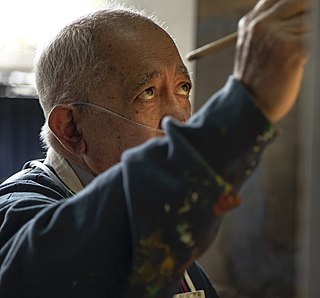
Gilberto Aceves Navarro was a Mexican painter and sculptor and a professor at the Escuela Nacional de Artes Plásticas and Academy of San Carlos. There have been more than two hundred individual exhibits of his work, with his murals found in Mexico, Japan and the United States. He received numerous awards for his work including grants as a Creador Artístico of the Sistema Nacional de Creadores de Arte, Premio Nacional de Ciencias y Artes and Bellas Artes Medal from the Instituto Nacional de Bellas Artes.

Ramón Alva de la Canal was a Mexican painter, illustrator, and educator, one of the pioneers of the Mexican muralism movement.

Oscar Melchor Peredo y Garcia is a Mexican muralist and a representative of the social realist school of mural painting in Mexico. His murals depict historical scenes from Mexican history with an emphasis on revolutionary subjects. His work is featured in public and government buildings across Mexico. He has also painted murals in the USA and Europe.
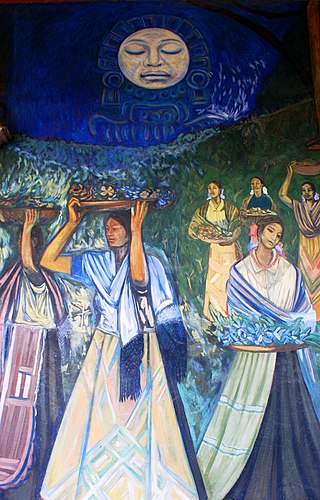
Alfredo Zalce Torres was a Mexican artist and contemporary of Diego Rivera, David Siqueiros and other better-known muralists. He worked principally as a painter, sculptor, and engraver, also taught, and was involved in the foundation of a number of institutions of culture and education. He is perhaps best known for his mural painting, typically imbued with "fervent social criticism". He is acclaimed as the first artist to borrow the traditional material of coloured cement as the medium for a "modern work of art". Publicity-shy, he is said to have turned down Mexico's Premio Nacional de Ciencias y Artes before finally accepting it in 2001. Before his death, Sotheby's described him as "the most important living Mexican artist up to date".

Xavier Guerrero was one of the pioneers of the Mexican muralism movement in the early 20th century. He was introduced to painting through working with his father, who worked in masonry and decorating. However, there is evidence that his ability was mostly self-taught. In 1912, he moved to Guadalajara and began painting murals, then to Mexico City in 1919 just as the muralism movement was about to begin. Most of his work was in collaboration with or subordinate to other painters such as Diego Rivera and David Alfaro Siqueiros, working at the San Ildefonso College, the Secretaría de Educación Pública building and the Universidad Autónoma de Chapingo; however, much of his other work has been lost. While best known for his mural work, his later canvas work is considered to be better.
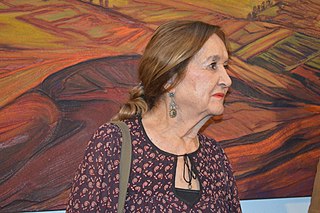
Rina Lazo Wasem was a Guatemalan-Mexican painter. She began her career in mural painting with Diego Rivera as his assistant. She worked with him from 1947 until his death in 1957 on projects both in Mexico and Guatemala. Thereafter, she remained an active painter, better known for her mural works than canvases, although the latter have been exhibited in Mexico and other countries. This has made her one of Guatemala's best-known artists. She was a member of the Mexican muralism movement and criticized modern artists as too commercial and not committed to social causes. She believed muralism would revive in Mexico because of its historical value.

Guillermo Ceniceros is a Mexican painter and muralist, best known for his mural work in Mexico City, as well as his figurative easel work. He began his mural painting career as an assistant to mural painters such as Federico Cantú, Luis Covarrubias and then David Alfaro Siqueiros who was a mentor and a key influence. Ceniceros is the most notable of Siqueiros' assistants. While he has experimented with abstract expression, his easel work mostly classifies as figurativism and is influenced by the geometrical construct of Mexican muralism. He has had over 300 individual and collective exhibitions in Mexico and the International stage. His work has been recognized by the Mexican Ministry of Culture and several of its institutions. He has painted over 20 large scale Mural Paintings with some of the most notable being the large scale work for the Legislative Palace of San Lazaro as well as his murals in the Metro Subway System. He is a member of the Salón de la Plástica Mexicana. In 1995, the State of Durango, Ceniceros' native state, opened to the public the Guillermo Ceniceros Art Museum within the oversight of the Ministry of Culture. Ceniceros has been reviewed by notable critics such as Berta Taracena, Raquel Tibol, Alaide Foppa, Graciela Kartofel, José Angel Leyva and Eduardo Blackaller among others. There are several publications about his work including a vast review of his art life endeavors developed by the Ministries of Culture of Durango and Nuevo León. He is married to the artist Esther González and lives in his studio house in the Colonia Roma of Mexico City.
Leonel Maciel is a Mexican artist, member of the Salón de la Plástica Mexicana, from the coast of the state of Guerrero. Although from a rural area and farming family, he studied art at the Escuela Nacional de Pintura, Escultura y Grabado "La Esmeralda" and has traveled extensively in Europe and Asia, which has influenced his work. His art has changed styles from generally contains multiple elements and saturated colors.
Mario Orozco Rivera was a Mexican muralist and painter, a later proponent of Mexican muralism, and whose work was particularly influenced by David Alfaro Siqueiros. He created a number of murals, mostly in the state of Veracruz before becoming an assistant to Siqueiros, directing the Taller Siqueiros in Cuernavaca and working with the artists on projects such as the Polyforum Cultural Siqueiros. While preferring mural work, which he considered less commercial, Orozco Rivera also created oils and sculptures. Many of these works were exhibited in Mexico and abroad and can be found in many major collections. His work received recognition in various countries.
